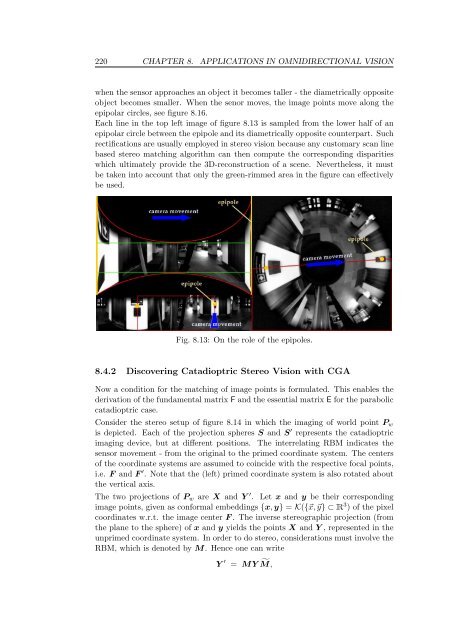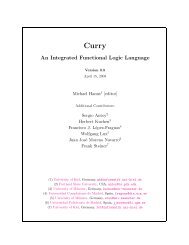- Page 1 and 2:
INSTITUT FÜR INFORMATIK Conformal
- Page 3 and 4:
Conformal Geometric Algebra in Stoc
- Page 5:
Dedicated to my beloved wife, Steph
- Page 9:
ACKNOWLEDGMENT This thesis as is ca
- Page 12 and 13:
3 The Conformal Geometric Algebra 8
- Page 14 and 15:
8 Applications in Omnidirectional V
- Page 16 and 17:
2 CHAPTER 1. INTRODUCTION with a si
- Page 18 and 19:
4 CHAPTER 1. INTRODUCTION three poi
- Page 20 and 21:
6 CHAPTER 1. INTRODUCTION Spherical
- Page 22 and 23:
8 CHAPTER 1. INTRODUCTION Fig. 1.3:
- Page 24 and 25:
10 CHAPTER 1. INTRODUCTION incidenc
- Page 26 and 27:
12 CHAPTER 1. INTRODUCTION tabular
- Page 28 and 29:
14 CHAPTER 1. INTRODUCTION
- Page 30 and 31:
16 CHAPTER 2. GEOMETRIC ALGEBRA Gra
- Page 32 and 33:
18 CHAPTER 2. GEOMETRIC ALGEBRA and
- Page 34 and 35:
20 CHAPTER 2. GEOMETRIC ALGEBRA 2.1
- Page 36 and 37:
22 CHAPTER 2. GEOMETRIC ALGEBRA fur
- Page 38 and 39:
24 CHAPTER 2. GEOMETRIC ALGEBRA Fig
- Page 40 and 41:
26 CHAPTER 2. GEOMETRIC ALGEBRA Fig
- Page 42 and 43:
28 CHAPTER 2. GEOMETRIC ALGEBRA Ret
- Page 44 and 45:
30 CHAPTER 2. GEOMETRIC ALGEBRA dou
- Page 46 and 47:
32 CHAPTER 2. GEOMETRIC ALGEBRA whe
- Page 48 and 49:
34 CHAPTER 2. GEOMETRIC ALGEBRA In
- Page 50 and 51:
36 CHAPTER 2. GEOMETRIC ALGEBRA 2.2
- Page 52 and 53:
38 CHAPTER 2. GEOMETRIC ALGEBRA geo
- Page 54 and 55:
40 CHAPTER 2. GEOMETRIC ALGEBRA fol
- Page 56 and 57:
42 CHAPTER 2. GEOMETRIC ALGEBRA Def
- Page 58 and 59:
44 CHAPTER 2. GEOMETRIC ALGEBRA sug
- Page 60 and 61:
46 CHAPTER 2. GEOMETRIC ALGEBRA In
- Page 62 and 63:
48 CHAPTER 2. GEOMETRIC ALGEBRA due
- Page 64 and 65:
50 CHAPTER 2. GEOMETRIC ALGEBRA the
- Page 66 and 67:
52 CHAPTER 2. GEOMETRIC ALGEBRA Cor
- Page 68 and 69:
54 CHAPTER 2. GEOMETRIC ALGEBRA Pur
- Page 70 and 71:
56 CHAPTER 2. GEOMETRIC ALGEBRA Pro
- Page 72 and 73:
58 CHAPTER 2. GEOMETRIC ALGEBRA Acc
- Page 74 and 75:
60 CHAPTER 2. GEOMETRIC ALGEBRA Pro
- Page 76 and 77:
62 CHAPTER 2. GEOMETRIC ALGEBRA it
- Page 78 and 79:
64 CHAPTER 2. GEOMETRIC ALGEBRA whe
- Page 80 and 81:
66 CHAPTER 2. GEOMETRIC ALGEBRA Let
- Page 82 and 83:
68 CHAPTER 2. GEOMETRIC ALGEBRA Sin
- Page 84 and 85:
70 CHAPTER 2. GEOMETRIC ALGEBRA Def
- Page 86 and 87:
72 CHAPTER 2. GEOMETRIC ALGEBRA The
- Page 88 and 89:
74 CHAPTER 2. GEOMETRIC ALGEBRA dua
- Page 90 and 91:
76 CHAPTER 2. GEOMETRIC ALGEBRA It
- Page 92 and 93:
78 CHAPTER 2. GEOMETRIC ALGEBRA If
- Page 94 and 95:
80 CHAPTER 2. GEOMETRIC ALGEBRA
- Page 96 and 97:
82 CHAPTER 3. THE CONFORMAL GEOMETR
- Page 98 and 99:
84 CHAPTER 3. THE CONFORMAL GEOMETR
- Page 100 and 101:
86 CHAPTER 3. THE CONFORMAL GEOMETR
- Page 102 and 103:
88 CHAPTER 3. THE CONFORMAL GEOMETR
- Page 104 and 105:
90 CHAPTER 3. THE CONFORMAL GEOMETR
- Page 106 and 107:
92 CHAPTER 3. THE CONFORMAL GEOMETR
- Page 108 and 109:
94 CHAPTER 3. THE CONFORMAL GEOMETR
- Page 110 and 111:
96 CHAPTER 3. THE CONFORMAL GEOMETR
- Page 112 and 113:
98 CHAPTER 3. THE CONFORMAL GEOMETR
- Page 114 and 115:
100 CHAPTER 3. THE CONFORMAL GEOMET
- Page 116 and 117:
102 CHAPTER 3. THE CONFORMAL GEOMET
- Page 118 and 119:
104 CHAPTER 3. THE CONFORMAL GEOMET
- Page 120 and 121:
106 CHAPTER 3. THE CONFORMAL GEOMET
- Page 122 and 123:
108 CHAPTER 3. THE CONFORMAL GEOMET
- Page 124 and 125:
110 CHAPTER 3. THE CONFORMAL GEOMET
- Page 126 and 127:
112 CHAPTER 3. THE CONFORMAL GEOMET
- Page 128 and 129:
114 CHAPTER 3. THE CONFORMAL GEOMET
- Page 130 and 131:
116 CHAPTER 3. THE CONFORMAL GEOMET
- Page 132 and 133:
118 CHAPTER 3. THE CONFORMAL GEOMET
- Page 134 and 135:
120 CHAPTER 3. THE CONFORMAL GEOMET
- Page 136 and 137:
122 CHAPTER 3. THE CONFORMAL GEOMET
- Page 138 and 139:
124 CHAPTER 3. THE CONFORMAL GEOMET
- Page 140 and 141:
126 CHAPTER 3. THE CONFORMAL GEOMET
- Page 142 and 143:
128 CHAPTER 3. THE CONFORMAL GEOMET
- Page 144 and 145:
130 CHAPTER 3. THE CONFORMAL GEOMET
- Page 146 and 147:
132 CHAPTER 3. THE CONFORMAL GEOMET
- Page 148 and 149:
134 CHAPTER 3. THE CONFORMAL GEOMET
- Page 150 and 151:
136 CHAPTER 4. A PRIMER ON POSE EST
- Page 152 and 153:
138 CHAPTER 4. A PRIMER ON POSE EST
- Page 154 and 155:
140 CHAPTER 4. A PRIMER ON POSE EST
- Page 156 and 157:
142 CHAPTER 4. A PRIMER ON POSE EST
- Page 158 and 159:
144 CHAPTER 4. A PRIMER ON POSE EST
- Page 160 and 161:
146 CHAPTER 5. PARAMETER ESTIMATION
- Page 162 and 163:
148 CHAPTER 5. PARAMETER ESTIMATION
- Page 164 and 165:
150 CHAPTER 5. PARAMETER ESTIMATION
- Page 166 and 167:
152 CHAPTER 5. PARAMETER ESTIMATION
- Page 168 and 169:
154 CHAPTER 5. PARAMETER ESTIMATION
- Page 170 and 171:
156 CHAPTER 5. PARAMETER ESTIMATION
- Page 172 and 173:
158 CHAPTER 5. PARAMETER ESTIMATION
- Page 174 and 175:
160 CHAPTER 5. PARAMETER ESTIMATION
- Page 176 and 177:
162 CHAPTER 5. PARAMETER ESTIMATION
- Page 178 and 179:
164 CHAPTER 5. PARAMETER ESTIMATION
- Page 180 and 181:
166 CHAPTER 5. PARAMETER ESTIMATION
- Page 182 and 183:
168 CHAPTER 5. PARAMETER ESTIMATION
- Page 184 and 185: 170 CHAPTER 5. PARAMETER ESTIMATION
- Page 186 and 187: 172 CHAPTER 5. PARAMETER ESTIMATION
- Page 188 and 189: 174 CHAPTER 5. PARAMETER ESTIMATION
- Page 190 and 191: 176 CHAPTER 5. PARAMETER ESTIMATION
- Page 192 and 193: 178 CHAPTER 5. PARAMETER ESTIMATION
- Page 194 and 195: 180 CHAPTER 6. PRACTICAL ASPECTS OF
- Page 196 and 197: 182 CHAPTER 6. PRACTICAL ASPECTS OF
- Page 198 and 199: 184 CHAPTER 6. PRACTICAL ASPECTS OF
- Page 200 and 201: 186 CHAPTER 6. PRACTICAL ASPECTS OF
- Page 202 and 203: 188 CHAPTER 6. PRACTICAL ASPECTS OF
- Page 204 and 205: 190 CHAPTER 7. APPLICATIONS IN COMP
- Page 206 and 207: 192 CHAPTER 7. APPLICATIONS IN COMP
- Page 208 and 209: 194 CHAPTER 7. APPLICATIONS IN COMP
- Page 210 and 211: 196 CHAPTER 7. APPLICATIONS IN COMP
- Page 212 and 213: 198 CHAPTER 7. APPLICATIONS IN COMP
- Page 214 and 215: 200 CHAPTER 7. APPLICATIONS IN COMP
- Page 216 and 217: 202 CHAPTER 7. APPLICATIONS IN COMP
- Page 218 and 219: 204 CHAPTER 8. APPLICATIONS IN OMNI
- Page 220 and 221: 206 CHAPTER 8. APPLICATIONS IN OMNI
- Page 222 and 223: 208 CHAPTER 8. APPLICATIONS IN OMNI
- Page 224 and 225: 210 CHAPTER 8. APPLICATIONS IN OMNI
- Page 226 and 227: 212 CHAPTER 8. APPLICATIONS IN OMNI
- Page 228 and 229: 214 CHAPTER 8. APPLICATIONS IN OMNI
- Page 230 and 231: 216 CHAPTER 8. APPLICATIONS IN OMNI
- Page 232 and 233: 218 CHAPTER 8. APPLICATIONS IN OMNI
- Page 236 and 237: 222 CHAPTER 8. APPLICATIONS IN OMNI
- Page 238 and 239: 224 CHAPTER 8. APPLICATIONS IN OMNI
- Page 240 and 241: 226 CHAPTER 8. APPLICATIONS IN OMNI
- Page 242 and 243: 228 CHAPTER 8. APPLICATIONS IN OMNI
- Page 244 and 245: 230 CHAPTER 8. APPLICATIONS IN OMNI
- Page 246 and 247: 232 CHAPTER 9. CONCLUSION • The m
- Page 248 and 249: 234 CHAPTER 9. CONCLUSION
- Page 250 and 251: 236 APPENDIX A. SELECTED ASPECTS UN
- Page 252 and 253: 238 APPENDIX A. SELECTED ASPECTS UN
- Page 254 and 255: 240 APPENDIX A. SELECTED ASPECTS UN
- Page 256 and 257: 242 APPENDIX A. SELECTED ASPECTS UN
- Page 258 and 259: 244 APPENDIX A. SELECTED ASPECTS UN
- Page 260 and 261: 246 APPENDIX A. SELECTED ASPECTS UN
- Page 262 and 263: 248 APPENDIX A. SELECTED ASPECTS UN
- Page 264 and 265: 250 APPENDIX A. SELECTED ASPECTS UN
- Page 266 and 267: 252 APPENDIX A. SELECTED ASPECTS UN
- Page 268 and 269: 254 APPENDIX B. ABBREVIATIONS
- Page 270 and 271: 256 APPENDIX C. NOTATION [A;B] Vert
- Page 272 and 273: 258 APPENDIX C. NOTATION
- Page 274 and 275: 260 APPENDIX C. NOTATION [11] E. Ba
- Page 276 and 277: 262 APPENDIX C. NOTATION [34] W. F
- Page 278 and 279: 264 APPENDIX C. NOTATION [59] R. M.
- Page 280 and 281: 266 APPENDIX C. NOTATION [86] D. Ni
- Page 282 and 283: 268 APPENDIX C. NOTATION [113] R. S
- Page 284 and 285:
270 APPENDIX C. NOTATION Conjugate,
- Page 286 and 287:
272 APPENDIX C. NOTATION vision, 11
















